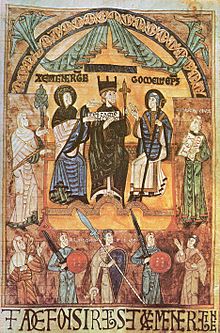Alfons III (Asturias)
Alfons III the Great (* 848 ; † December 20, 910 in Zamora ) was King of Asturias from 866 until his deposition in the summer of 910 . He succeeded his father Ordoño I on the throne.
government
At the age of eighteen, Alfons succeeded his father. In addition to Asturias, Galicia and the area around the city of León also belonged to the kingdom that he inherited . Ordoño I had taken possession of León and initiated the repopulation of the city, Alfons made León his preferred residence. He effectively moved the capital of the Asturian Empire from Oviedo to León, thus setting the course for the creation of the Kingdom of León . He subjugated Navarre, which had fallen under Count Sancho of Bigorre (873) and his son Garcias (885) . He fought against the emirate of Cordoba with varying success, benefiting from the fact that the Muslims were weakened by civil wars. His troops advanced into Old Castile and were also advancing in Portugal , where they occupied Coimbra . The empire expanded greatly.
Alfons played an important role in the repopulation ( Repoblación ) of the depopulated border regions ("belt of devastation") from which the Muslims had been expelled. He pushed forward with the resettlement vigorously.
Alfons married Jimena, who came from the Navarre royal family, around 869. Possibly she was a daughter of King García Íñiguez . With her he had the sons García , Ordoño and Fruela . García, the oldest, embarked on a rebellion in the final stages of Alfonso's reign. When the uprising was suppressed and García imprisoned, the younger sons allied with the queen in a conspiracy. They forced Alfonso to release García, dethroned the king and divided the empire among themselves. After his deposition, Alfons went into exile in the summer of 910 and died soon afterwards.
timeline
Alfons III has a chronicle, the Crónica de Alfonso III named after him , either himself written (which is likely) or at least commissioned and supervised its writing. This chronicle describes the history of the Visigoth Empire from 672 and that of the Asturian Empire until Alfonso took office, and it has shaped later historiography. It is a tendentious source that contains historical falsifications and was used for the ruler's propaganda. Alfonso depicts the Asturian Empire as a continuation of the fallen Visigoth Empire (Neo-Gothicism). According to his account, the cause of the defeat of the Visigoths against the Muslims was the sexual excesses of the last Visigoth kings Witiza and Roderich , who challenged the wrath of God. The neo-Gothicism propagated by Alfons served to legitimize rule and became an important ideological driving force of the Reconquista .
Text editions of the Chronicle of Alfonso III.
- Jan Prelog (Ed.): The Chronicle of Alfonso III. Peter Lang, Frankfurt a. M. 1980, ISBN 3-8204-6688-6 (Latin text with German commentary)
- Yves Bonnaz (Ed.): Chroniques asturiennes . Éditions du CNRS, Paris 1987, ISBN 2-222-03516-3 (Latin text with French translation and detailed commentary)
- Juan Gil Fernández (Ed.): Crónicas asturianas . Oviedo 1985, ISBN 84-600-4405-X (Latin text and Spanish translation)
- Juan Gil (Ed.): Chronica Hispana saeculi VIII et IX (= Corpus Christianorum . Continuatio Mediaevalis , Vol. 65). Brepols, Turnhout 2018, ISBN 978-2-503-57481-3 , pp. 383-433 (critical edition)
literature
- Paulino García Toraño: Historia de el Reino de Asturias . Oviedo 1986, ISBN 84-398-6586-4 , pp. 283-341
- Claudio Sánchez-Albornoz: Orígenes de la nación española , Volume 3, Instituto de Estudios Asturianos, Oviedo 1975, ISBN 84-00-04168-2 , pp. 493-962
- Ludwig Vones: History of the Iberian Peninsula in the Middle Ages 711-1480 . Thorbecke, Sigmaringen 1993, ISBN 3-7995-7113-2 , pp. 38-40
Web links
Remarks
- ↑ On the year of birth see Claudio Sánchez-Albornoz: Orígenes de la nación española , Volume 3, Oviedo 1975, pp. 601–605.
- ↑ On the ancestry of Jimena see the detailed study by Claudio Sánchez-Albornoz: Orígenes de la nación española , Volume 3, Oviedo 1975, pp. 631–649; on the dating of the wedding pp. 655–659.
- ↑ Alexander Pierre Bronisch: Reconquista and Holy War , Münster 1998, pp. 124f., 371–395 with a discussion of the older literature.
- ↑ Bronisch (1998) pp. 126-139, 235-276 with a discussion of the older literature. See also the supplementary work by Bronisch: The Visigoth Empire ideology and its further development in the Empire of Asturias , in: The early Middle Ages Kings , ed. Franz-Reiner Erkens, Berlin 2005, pp. 182-187.
| predecessor | Office | successor |
|---|---|---|
| Ordoño I. |
King of Asturias 866–910 |
García I. (León) Ordoño II. (Galicia) Fruela II. (Asturias) |
| personal data | |
|---|---|
| SURNAME | Alfons III |
| ALTERNATIVE NAMES | Alfons III the great |
| BRIEF DESCRIPTION | King of Asturias |
| DATE OF BIRTH | 848 |
| DATE OF DEATH | December 20, 910 |
| Place of death | Zamaro , Spain |
